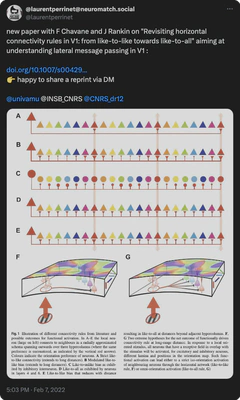Revisiting Horizontal Connectivity Rules in V1: From like-to-like towards like-to-All
Abstract
Horizontal connections in the primary visual cortex of carnivores, ungulates and primates organize on a near-regular lattice. Given the similar length scale for the regularity found in cortical orientation maps, the currently accepted theoretical standpoint is that these maps are underpinned by a like-to-like connectivity rule: horizontal axons connect preferentially to neurons with similar preferred orientation. However, there is reason to doubt the rule’s explanatory power, since a growing number of quantitative studies show that the like-to-like connectivity preference and bias mostly observed at short-range scale, are highly variable on a neuron-to-neuron level and depend on the origin of the presynaptic neuron. Despite the wide availability of published data, the accepted model of visual processing has never been revised. Here,~we review three lines of independent evidence supporting a much-needed revision of the like-to-like connectivity rule, ranging from anatomy to population functional measures, computational models and to theoretical approaches. We advocate an alternative, distance-dependent connectivity rule that is consistent with new structural and functional evidence: from like-to-like bias at short horizontal distance to like-to-all at long horizontal distance. This generic rule accounts for the observed high heterogeneity in interactions between the orientation and retinotopic domains, that we argue is necessary to process non-trivial stimuli in a task-dependent manner.
